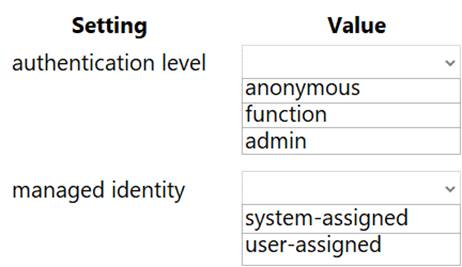HOTSPOT - (Topic 8)
You plan to deploy a web app to App Service on Linux. You create an App Service plan. You create and push a custom Docker image that image that contains the web app to Azure Container Registry.
You need to access the console logs generated from inside the container in real-time. How should you complete the Azure CLI command? To answer, select the appropriate options in the answer area.
NOTE: Each correct selection is worth one point.
Solution:
Box 1: config
To Configure logging for a web app use the command: az webapp log config
Box 2: --docker-container-logging Syntax include:
az webapp log config [--docker-container-logging {filesystem, off}]
Box 3: webapp
To download a web app's log history as a zip file use the command: az webapp log download
Box 4: download References:
https://docs.microsoft.com/en-us/cli/azure/webapp/log
Does this meet the goal?
Correct Answer:
A
HOTSPOT - (Topic 8)
A company develops a series of mobile games. All games use a single leaderboard service.
You have the following requirements:
•Code should be scalable and allow for growth.
•Each record must consist of a playedId, gameId, score, and time played.
•When users reach a new high score, the system will save the new score using the SaveScore function below.
•Each game is assigned and Id based on the series title.
You have the following code. (Line numbers are included for reference only.)
You store customer information in an Azure Cosmos database. The following data already exists in the database:

For each of the following statements, select Yes if the statement is true. Otherwise, select No.
NOTE:Each correct selection is worth one point.
Solution:
Box 1: Yes
Code for CosmosDB, example:
// Parse the connection string and return a reference to the storage account. CloudStorageAccount storageAccount = CloudStorageAccount.Parse( CloudConfigurationManager.GetSetting("StorageConnectionString"));
// Create the table client.
CloudTableClient tableClient = storageAccount.CreateCloudTableClient();
// Retrieve a reference to the table.
CloudTable table = tableClient.GetTableReference("people");
// Create the TableOperation object that inserts the customer entity. TableOperation insertOperation = TableOperation.Insert(customer1);
Box 2: No
A new record will always be added as TableOperation.Insert is used, instead of TableOperation.InsertOrReplace.
Box 3: No
No partition key is used. Box 4: Yes
References:
https://docs.microsoft.com/en-us/azure/cosmos-db/table-storage-how-to-use-dotnet
Does this meet the goal?
Correct Answer:
A
HOTSPOT - (Topic 3)
You need to correct the Azure Logic app error message.
Which configuration values should you use? To answer, select the appropriate options in the answer area.
NOTE:Each correct selection is worth one point.
Solution:
Scenario: You test the Logic app in a development environment. The following error message displays:
'400 Bad Request'
Troubleshooting of the error shows an HttpTrigger action to call the RequestUserApproval function.
Note: If the inbound call's request body doesn't match your schema, the trigger returns an HTTP 400 Bad Request error.
Box 1: function
If you have an Azure function where you want to use the system-assigned identity, first enable authentication for Azure functions.
Box 2: system-assigned
Your logic app or individual connections can use either the system-assigned identity or a single user-assigned identity, which you can share across a group of logic apps, but not both.
Does this meet the goal?
Correct Answer:
A
- (Topic 8)
Note: This question is part of a series of questions that present the same scenario. Each question in the series contains a unique solution that might meet the stated goals. Some question sets might have more than one correct solution, while others might not have a correct solution.
After you answer a question in this section, you will NOT be able to return to it. As a result, these questions will not appear in the review screen.
You develop and deploy an Azure App Service API app to a Windows-hosted deployment slot named Development. You create additional deployment slots namedTestingand Production. You enable auto swap on the Production deployment slot.
You need to ensure that scripts run and resources are available before a swap operation occurs.
Solution: Update the web.config file to include the applicationInitialization configuration element. Specify custom initialization actions to run the scripts.
Does the solution meet the goal?
Correct Answer:
A
Specify custom warm-up.
Some apps might require custom warm-up actions before the swap. The applicationInitialization configuration element in web.config lets you specify custom initialization actions. The swap operation waits for this custom warm-up to finish before swapping with the target slot. Here's a sample web.config fragment.
Reference:
https://docs.microsoft.com/en-us/azure/app-service/deploy-staging-slots#troubleshoot- swaps
DRAG DROP - (Topic 8)
You are developing Azure WebJobs.
You need to recommend a WebJob type for each scenario.
Which WebJob type should you recommend? To answer, drag the appropriate WebJob types to the correct scenarios. Each WebJob type may be used once, more than once, or not at all. You may need to drag the split bar between panes or scroll to view content.
NOTE:Each correct selection is worth one point.
Solution:
Box 1: Continuous
Continuous runs on all instances that the web app runs on. You can optionally restrict the WebJob to a single instance.
Box 2: Triggered
Triggered runs on a single instance that Azure selects for load balancing.
Box 3: Continuous
Continuous supports remote debugging.
Note:
The following table describes the differences between continuous and triggered WebJobs.
References:
https://docs.microsoft.com/en-us/azure/app-service/web-sites-create-web-jobs
Does this meet the goal?
Correct Answer:
A

